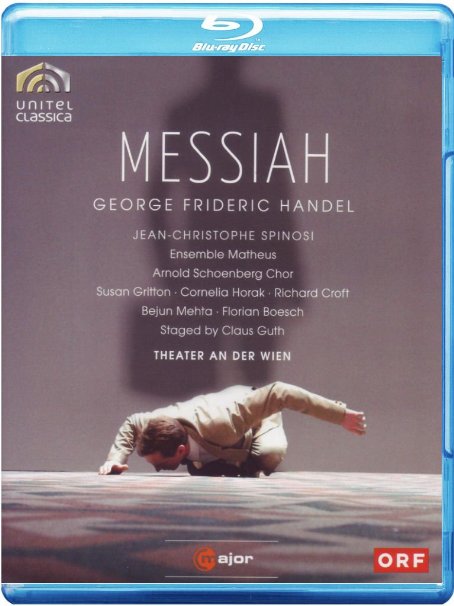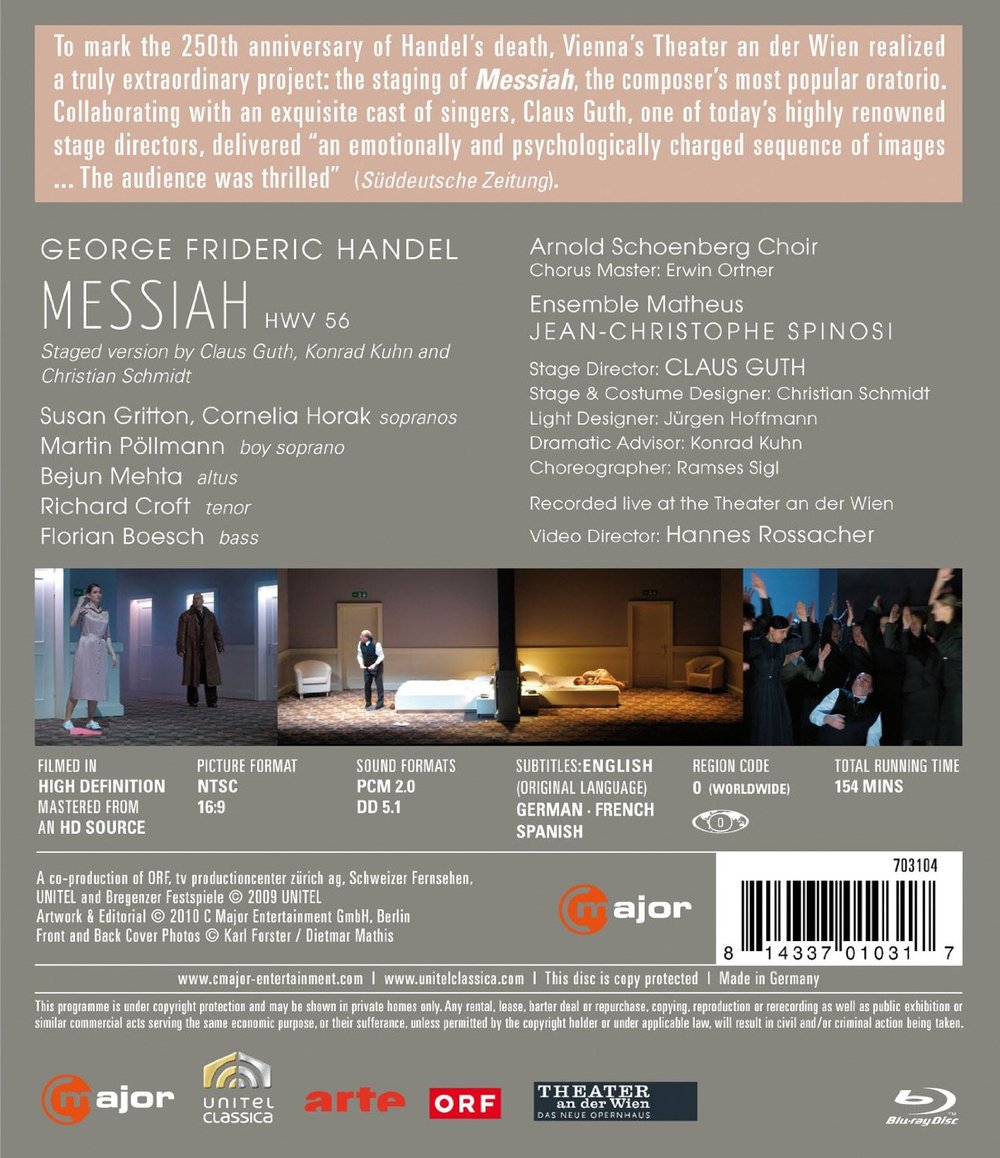

Handel Messiah oratorio to libretto by Charles Jennens. Staged 2009 by Claus Guth at the Theater an der Wien. Stars Susan Gritton (soprano), Cornelia Horak (soprano), Martin Pöllmann (boy soprano), Bejun Mehta (altus), Richard Croft (tenor), Florian Boesch (bass), Paul Lorenger (dancer), and Nadia Kichler (sign language performer). Jean-Christophe Spinosi conducts the Ensemble Matheus and the Arnold Schoenberg Chor (Chorus Master Erwin Ortner). Set and costume design by Christian Schmidt; lighting design by Jürgen Hoffman; dramatic advice by Konrad Kuhn; choreography by Ramses Sigl. Directed for TV by Hannes Rossacher. Sung in English. Released in 2010, disc has 5.0 dts-HD Master Audio sound output. Grade: A
Here are comments from Wonk Gordon Smith made in 2011:
“Messiah has always been, for me, an iconic work. For many British people it might even be considered as sacred as the texts on which it is based. There are many traditions surrounding it, such as the way everyone stands up for the "Hallelujah Chorus" (because at a performance in 1743, King George II stood up when he heard the first notes, and everybody followed suit).
When I heard that the Theater an der Wien had produced a staged version of Messiah directed by controversial director Claus Guth, I was intrigued and somewhat dubious. Would this be an iconoclastic piece of monumental Eurotrash or something unique and special?
When you go to see a new production of Tosca or The Marriage of Figaro, you always know, more or less, what is going to happen. It may be set in the trenches of the First World War or in a jam factory . . . but the music will be familiar and the plot the same. In the case of Messiah, the music is indeed familiar. But the storyline weaved around it will obviously be completely new. And this is what makes Claus Guth's production so absorbing—you really do not know what's coming next!
The first thing to say is that, in terms of orchestral playing and vocal quality, this is probably the very best Messiah I have ever heard. The soloists are outstanding. They also bring an unprecedented degree of passion and involvement to their singing because they are part of the drama that is unfolding before our eyes. In addition, they are all excellent actors who manage to give a full vocal delivery despite being hunched up on the floor, lying on a bed, leaning forwards or backwards, or directed in any combination of the above. Close your eyes and compare this performance with your conventional static interpretation in a cavernous church with the choir standing in neat rows and soloists sedately coming forward to sing their piece and then retiring to the shadows. Well, there is no comparison! This version wins hands down! And here, by the way, the chorus does anything but stand in neat rows: it is carefully choreographed with hand and arm movements invariably giving an additional thrust to the meaning of the words the chorus is singing.
So what is this story woven around the hallowed music of Messiah? As the curtain rises, we see the intriguing figure of a girl, in a corridor, communicating in sign language as an accompaniment to the opening "Sinfonia." The tenor, Richard Croft, dressed as a priest, appears to sing "Comfort ye my people." Immediately you feel the sincerity and heartfelt sympathy in his superb voice. He moves forward towards a door as the huge turntable on which the set is built rotates to reveal a funeral taking place in a funeral home, complete with coffin, mourners, and congregation. It is of course the congregation that sings "And the glory of the Lord shall be revealed" as the priest comes in and the bereaved brother (Bejun Mehta, a simply amazing counter-tenor) sings "But who may abide the day of His coming."
And so it goes on. The narrative which has been built around the text is engrossing and moving. It deals with relationships, the happiness of a birth, the suffering of a betrayed relationship, professional pressures, suicide, grief, mourning, and even efforts by the priest to cover up the suicide so that the decedent can have a Christian burial. It may it hard for you to believe, but all of these events are appropriately accompanied by the well-loved words and music of Handel's masterpiece.
Once you have realized how the work is being played out, you start wondering how this or that well-known aria/chorus will be treated. For example, what will they do for "How beautiful are the feet"? Well, I won't give all the secrets away. Get this disc and see for yourself!
The central figure—who may represent Christ or the human condition—is played by a dancer who expresses his emotions silently and sometimes energetically. It may just be that occasionally he goes a little over the top. But it may only seem that way to us because we are treated to close-up views; from the auditorium the motions would not seem so intense. The dancer's expressiveness is frequently offset by the sign language of the angelic (?) woman who perhaps symbolizes the mysterious purposes of God.
So, is this Eurotrash or something unique and special? As far as I am concerned, it is undoubtedly the latter. And the often rather staid Viennese audience apparently agreed, judging by their rapturous applause and cheers during the curtain calls. This won't please everyone, of course. Some might even feel offended. But they should bear in mind that the first performance of this work in London was not in a church, but in a theater (Covent Garden) and that Handel himself called it an "entertainment." In fact, I would even go so far as to say that this production is more entertaining than a great many of Handel's long and repetitive "proper" operas. This is certainly a superbly staged production. It is musically outstanding. Technically, picture and sound quality are superlative and totally involving. In short, this is a unique HDVD experience you are never likely to forget!”
Gordon Smith gave this Messiah the grade of A-, and later the OperaDou jury also gave it A- also.
Now let's turn to some screenshots and further comments. First meet the angelic Nadia Kichler. She was apparently born deaf and has a career as a signing (not singing) actress. I think she is in fact making Guth's story accessible to a deaf audience. But she goes much further than simply being an interpreter—she becomes as actress an important character in the libretto who appears in various guises. Here's what I think she is telling us: "Through my signs, I help the deaf understand this opera. But if you are hearing and wish to understand this opera, you must open your mind and heart to accept things unlike what you have ever seen or heard before."
The funeral. The figure of Christ does not appear in the Messiah score. But in Guth's opera there is a Christ-like figure—a prominent man whose picture is seen below at his funeral. It's not explained if the decedent was a businessman, an executive in a non-profit enterprise, a professional, or even a politician. I call him the Leader, and he has a following (represented by the chorus). To (your) left on the front row nearest to coffin sits the Leader's wife and her mother (the Leader's mother-in-law). At the end of the left front row sits a man who was close to the Leader, whom I call the Iconoclast. To your right of the coffin, here sits on the front row a blond woman, her young son, and another man who is the husband of the blond woman. I call this husband the Betrayer. Guth suggested that the Iconoclast and the Betrayer could be brothers of the Leader, but prefer to think of them as followers or friends of the Leader:
Next below is a close-up of the Leader's wife (Cornelia Horak). She isn't just grieving. She knows her adultery contributed to her husband's death:
A good shot of the Iconoclast (Florian Boesch), who has figured out what caused the Leader's death:
At the funeral the Iconoclast barges his way into the ceremony to show everyone how the Leader died: The Leader cut deep gashes in both wrists and bled to death!
The blonde woman (Susan Gritton), her son (Martin Pöllman), and the Betrayer (Bejun Mehta) are all aghast and the funeral becomes increasingly bizarre:
After the funeral, we enter a series of flashbacks about what led to the suicide of the Leader. The chorus sings "For unto us a Child is born." At a baptism ceremony below the young man sings "And suddenly there was with the angel" as part of the happy scene. Below from left to right here you see the Leader (dancer Paul Lorenger), the wife, a friend, the Leader's mother-in-law, the young man, the blond woman, and the Betrayer. The Leader is aware that his marriage is collapsing:
The Leader's professional life is also collapsing. He receives an urgent phone call and immediately leaves the baptism ceremony, much to the chagrin of the others:
The Leader has no energy left for his wife:
The wife and the Betrayer can no longer restrain their desires:
Now the Leader, who appears to be blameless, has suffered complete defeat of his professional ambitions. The Chorus mourns:
The Priest (Richard Croft) tries to commiserate with the mourners:
While the wife and the Betrayer find their own way to assuage their pain:
"How beautiful are the feet":
The Leader's life is shattered. The Iconoclast finds the body:
And now we are finished with flashbacks and are back to the beginning of the funeral with "Hallelujah", the most famous chorus from Messiah:
A close-up of the chorus and the angel:
After the funeral there follows a variation of the theme of the Last Supper. By now the blond woman knows that she also has been betrayed:
The Iconoclast is not so forgiving:
And there is a resurrection. But where does each protagonist do next?
Every critic I've read praises the soloists, the chorus, and the orchestra in this recording. I agree with Gordon Smith that Guth's opera gives us a unique way to scrub off the grime of centuries and behold Messiah afresh. It can reach the agnostic. At can also remind Christians that the ancient texts were intended to be applied to current events.
The video was state-of-the art in 2009 in all respects. The Hannes Rossacher video pace is a probably a tad too fast, but it provides a gripping viewing experience. I would have given this an A or A+ in 2009. I suspect Gordon's reduction of the grade to A- was a concession to the feelings of traditionalists who might have been perplexed by the unconventional telling of Jennens' libretto. This HDVD has held up remarkably well for 8 years, and I feel it deserves an upgrade to A. But it is obviousy not the answer for folks who want a knock-out traditional style video recording of Messiah.
OR




















